Introduction
 It is a popular belief that Pujya Sri Raghavendra is the reincarnation of Sankukarna, Prahlada, Bahlika, and Vyasaraja tirtha in order. In his previous incarnation, Pujya Sri Raghavendra was Sri Vyasaraja, who had established 732 shrines for Lord Anjaneya and had personally worshipped Lord Venkateswara. It is no wonder that Pujya Sri Raghavendra was named Venkatanatha in this incarnation and a devotee of Lord Venkateswara. It is believed that Pujya Sri Raghavendra is a living saint and answers the devotees immediately. Today, Mantralaya is a place where people go seeking Pujya Sri Raghavendra's blessings. They come back with a smile and a lot of confidence in winning the situation. Pujya Raghavendra is the one who first worshipped Lord Anjaneya with five faces known as 'pancha muki Anjaneya'.
It is a popular belief that Pujya Sri Raghavendra is the reincarnation of Sankukarna, Prahlada, Bahlika, and Vyasaraja tirtha in order. In his previous incarnation, Pujya Sri Raghavendra was Sri Vyasaraja, who had established 732 shrines for Lord Anjaneya and had personally worshipped Lord Venkateswara. It is no wonder that Pujya Sri Raghavendra was named Venkatanatha in this incarnation and a devotee of Lord Venkateswara. It is believed that Pujya Sri Raghavendra is a living saint and answers the devotees immediately. Today, Mantralaya is a place where people go seeking Pujya Sri Raghavendra's blessings. They come back with a smile and a lot of confidence in winning the situation. Pujya Raghavendra is the one who first worshipped Lord Anjaneya with five faces known as 'pancha muki Anjaneya'.
Birth of a Yogi
Sri Thimmanna Bhat and his wife Gopikambal were living in Hampi near Haspet of the Bellary district of present-day Karnataka. Thimmanna Bhat is an exponent of playing Veena, like his ancestors. He was an ardent devotee of Lord Venkatachalapathy of Tirumala. This couple was not having any children; hence they went to Tirumala and prayed to the Lord. Thereafter, they were blessed with a girl child and two boys. The elder son was named Gururaja, and the younger was named Venkatanatha after the Lord of Tirumala. The younger one was born in the year 1595 while his parents were living in Bhuvanagiri near Chitambaram. Sri Venkatanatha performed the uppanayanam (the sacred thread ceremony) and was taught Vedas. He was sent to study under Sri Lakshmi Narasimhachar, who was married to his elder sister. He had proved to be an excellent student and was very sharp in understanding even the intrinsic meanings. After the parents passed away, Gururajan took charge of the family as he was an elder. The family moved to the nearby place, Kumbakonam, which is very much known as the seat for learning Veda. While Gururaja was proud of his brother's knowledge and keenness he was showing in learning, he was equally worried about seeing his brother's inclination towards philosophy. So he got his brother Sri Venkatanatha married to a pious lady, Saraswati, who hailed from Bhuvanagiri. Sri Venkatanatha had not shown any interest in the materialistic world and was more philanthropic.
Stay and Study at Sri Vidya Mutt, Kumbakonam
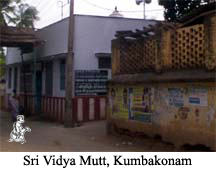 Therefore, due to necessity, the family moved to the Vidya mutt, where Sri Sri. Sudhindra Tirtha was the head. The Guru was so pleased to have Sri Venkatanatha as one of his students. He had no hesitation in his thought that this young, brilliant student will be the best suitable successor to his mutt after his time. Sri Venkatanatha learned Vyakarna and Sashtras alike and was very quick in grasping things. He used to sit on the banks of the river Cauvery and teach students who used to come there to get clarification as the lessons taught. His prowess to learn more and quickness to grasp made him the best among the disciples of their Guru.
Therefore, due to necessity, the family moved to the Vidya mutt, where Sri Sri. Sudhindra Tirtha was the head. The Guru was so pleased to have Sri Venkatanatha as one of his students. He had no hesitation in his thought that this young, brilliant student will be the best suitable successor to his mutt after his time. Sri Venkatanatha learned Vyakarna and Sashtras alike and was very quick in grasping things. He used to sit on the banks of the river Cauvery and teach students who used to come there to get clarification as the lessons taught. His prowess to learn more and quickness to grasp made him the best among the disciples of their Guru.
Envying at this development, some fellow students went and complained about Sri Venkatanatha to their Guru. On the night Guru went on rounds to the hostel and found all the students' deep asleep but could not find Sri Venkatanatha. He found him sleeping under the purana (old) mandapam, and there were some palm leaves by his side. Guruji had taken his upper cloth and draped it on Sri Venkatanatha and took away the palm leaves written by him. To the surprise of Guru Sri Sudhindra Tirtha, this student of his has written the Vyakarna for the lesson taught during the day. The next day, Sri Sudhindra Tirtha, in the assemblage of students, explained about the incident the previous night and read out the Vyakarna written by Sri Venkatanatha, putting to shame the act of others who were complaining.
Sri Venkatanatha, the scholar
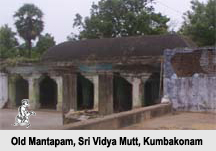 Sri Sudhindra Tirtha would take Sri Venkatanatha along with him when he went on pilgrimage. Sri Venkatanatha had extraordinary skill in Tharka (countering) and had won many accolades from learned scholars.
Sri Sudhindra Tirtha would take Sri Venkatanatha along with him when he went on pilgrimage. Sri Venkatanatha had extraordinary skill in Tharka (countering) and had won many accolades from learned scholars.
After completing his Gurukula at Kumbakonam, he returned to Bhuvanagiri and engaged in teaching. He was then blessed with a child, and they had named him Lakshmi Narasimha. On an occasion when he went to attend a yagya, other pundits around him thought of him as an ordinary purohit and asked him to prepare the sandal paste. Sri Venkatanatha prepared the paste, chanting "AgniSukta." When the sandal paste was applied by the pundits, their bodies had a burning sensation. Then Sri Venkatanatha gave them the sandal paste made by chanting "VarunaSukta." On applying this paste, their burning sensation receded and started cooling. Then those pundits realised that he is no ordinary purohit and was given the honourable seat of performing the yagya.
Sri Venkatanatha's dilemma
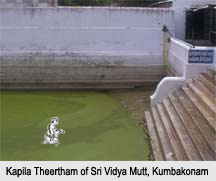 In the meantime, Sri Sudhindra Tirtha, who was becoming sick physically, called Sri Venkatanatha and asked him to take up the charge of his mutt after him. Sri Venkatanatha replied that he is still not mature enough to take up such responsibility. Therefore, Sri Sudhindra Tirtha made up his mind to hand over the responsibilities to another disciple by name Sri Yadavendra. While this arrangement continued, Sri Yadavendra went on a camp, and Sri Sudhindra Tirtha fell gravely sick. On that night, Sri MoolaRama, whom the Guru worships, appeared in his dreams and told him that Sri Venkatanatha was born to worship Him, and hence he should again appeal to Sri Venkatanatha. Guruji called Sri Venkatanatha and gave the Sri MoolaRama's message. Even now, Venkatanatha was hesitant to accept the responsibility of mutt, citing his duties as husband and father. On return to his home on the night God Vidya Lakshmi appeared in his dream and ordered Sri Venkatanatha to take the responsibility of worshipping Sri MoolaRama. After this divine direction, Sri Venkatanatha performed his duties as father by celebrating the upanayanam of his son. His wife Saraswati inferred from his actions that he had taken a decision to become Sanyasi. This accumulated in her mind as an agony, preparing herself to give up her life if required.
In the meantime, Sri Sudhindra Tirtha, who was becoming sick physically, called Sri Venkatanatha and asked him to take up the charge of his mutt after him. Sri Venkatanatha replied that he is still not mature enough to take up such responsibility. Therefore, Sri Sudhindra Tirtha made up his mind to hand over the responsibilities to another disciple by name Sri Yadavendra. While this arrangement continued, Sri Yadavendra went on a camp, and Sri Sudhindra Tirtha fell gravely sick. On that night, Sri MoolaRama, whom the Guru worships, appeared in his dreams and told him that Sri Venkatanatha was born to worship Him, and hence he should again appeal to Sri Venkatanatha. Guruji called Sri Venkatanatha and gave the Sri MoolaRama's message. Even now, Venkatanatha was hesitant to accept the responsibility of mutt, citing his duties as husband and father. On return to his home on the night God Vidya Lakshmi appeared in his dream and ordered Sri Venkatanatha to take the responsibility of worshipping Sri MoolaRama. After this divine direction, Sri Venkatanatha performed his duties as father by celebrating the upanayanam of his son. His wife Saraswati inferred from his actions that he had taken a decision to become Sanyasi. This accumulated in her mind as an agony, preparing herself to give up her life if required.
Ascend to Sanyasa
A day was selected for Sri Venkatanatha to embrace saintly hood. He was accorded a royal welcome in Thanjavur on the banks of Vadavaru, and the ceremony of accepting Sanyasa has been made a memorable one by the then kingdom of Thanjavur. Sri Raghunatha Nayaka, then king of Thanjavur, had supervised the arrangements. After the ceremonies at Vadavaru banks, where Sri Venkatanatha had become "Sri Raghavendra Tirtha" on the embracing of sanyasa, he was given royal reception at the Thanjavur Palace by the King. Sri Sudhindra Tirtha then handed over the responsibilities of the Sri Vidya mutt to Sri Raghavendra Tirtha.
Baratha vijayam
On hearing the news of her husband becoming a Sanyasi, Smt. Saraswati handed over her son to her relatives and decided to give off her life. Accordingly, she jumped into a well, killing herself. Sri Raghavendra Tirtha relieved her from the cycle of birth and rebirth and accorded her a status of 'nitya sumangali'. Guru Raghavendra started discharging his duty as head of the Sri Vidya mutt by attending to the pooja of Sri MoolaRama. He had started writing commentaries for many ancient works; he explained the interstices meaning of Vedas and Puranas. He interacted with the students of the Gurukula and scholars who met him and discussed with them the various aspects of the Vedas. He started moving throughout the Bharath to spread the Dvaita philosophy advocated by Sri Madhvacharya. While he was at Udupi, he rejoiced, singing in praise of Lord Krishna of Udipi. He had composed many songs in praise of Him under the nickname Venugopalan.
Grace of Guru
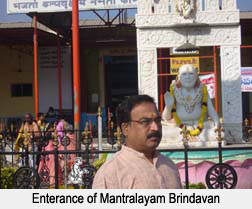 He had performed many miracles during his journey. Once, while travelling across a deserted area during a hot summer along with his devotees, one of the devotee’s wives was withering in pain to deliver a child. In order to help the women deliver the child safely, Guru Raghavendra performed the miracle of producing water from the ground by making a hole with the help of his Dhanda. He also produced shade by simply keeping his upper cloth floating in the space.
He had performed many miracles during his journey. Once, while travelling across a deserted area during a hot summer along with his devotees, one of the devotee’s wives was withering in pain to deliver a child. In order to help the women deliver the child safely, Guru Raghavendra performed the miracle of producing water from the ground by making a hole with the help of his Dhanda. He also produced shade by simply keeping his upper cloth floating in the space.
While camping at a village in Kridagiri, he was performing Sri MoolaRama pooja at the village chieftain's house. At that time the chieftain's son accidentally fell into the food prepared and kept for serving and died. The chieftain and his wife, not willing to disrupt the pooja, locked the kid's body in a room and continued with the pooja. Guru Raghavendra came to know of this and went into the room. He chanted some manthras and gave life to the kid. The chieftain then gave the entire village as Guru Dhakshina to Guru Raghavendra.
Venkkanna, the Diwan of Adoni
In a place called Adoni (a place near Humpi), a young Shepard boy who was gracing cattle saw Guru Raghavendra and grieved that since the family was poor he could not go to school and educate himself. And he wished he was literate. Guru Raghavendra blessed the boy and gave him mantrakshate (sacred rice grains) and told him to remember him in times of need. As the years passed, the boy Venkanna grew up and chanced to meet Azadulla Khan, the representative of Sultan who had come to Adoni to recruit people for the army. While at camp, a messenger had delivered a written document from Sultan addressed to his lieutenant Azadulla Khan. Azadulla Khan, who was illiterate, was looking around to see for somebody to read the message for him. He saw Venkanna with tufts and thought that this young man with tufts would be a wise man. Therefore, Venkanna, who was standing nearby, was asked to read the message from Sultan. When told that he is illiterate, Khan ordered that if the message is not read by him, his head will be cut off. Sri Venkanna, on hearing this, prayed to Guru Raghavendra for help, and to the astonishment of all, he read the letter. It was news from the Sultan to his lieutenant Azadulla Khan in praise of his service to the Sultanate. On hearing the good news, Azadulla Khan made Venkanna Diwan of Adoni.
Sesame seeds and Asada month
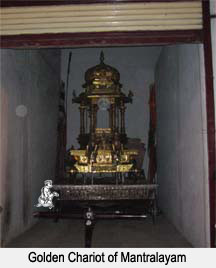 In a place called Malawi, Guru Raghavendra was performing the pooja of Sri MoolaRama while staying at a temple. A young man was witnessing the pooja from outside the temple. When he was asked to come near, he told me that he is from a different class and he is not permitted to enter the temple. Hearing this, Guru Raghavendra said that there is no differentiation in the creation of God. Hence, I invited him inside the temple and embraced him in the presence of all. Guru Raghavendra also said that he could give anything for performing the pooja of MoolaRama. The young man gave mustard seeds for the pooja, as he had only that. This happened during the month of Asada of the lunar calendar, during which period traditionally the mustard seeds are not taken in the food. But since this has been given with a lot of love for the pooja of Sri MoolaRama, on that day these mustard seeds were cooked and served as an offering. A pundit by name Nasmachar was reluctant to take the food offered by the mutt. Guru Raghavendra had ordered that food without mustard seeds be prepared and served to the pundit. Accordingly, Narasimhachar was offered a special food while Guru Raghavendra had taken the prasadam made of mustard seeds. Narasimhachar took the mantrakshate offered by Guru Raghavendra and left for home. To the astonishment of the pundit, the mantrakshate had turned black when he opened at his house. Fearing he had committed an error, he rushed back to Guru Raghavendra. A food that has been offered to God with love is Prasad, which, if taken with a half heart, is a food. Therefore, any offering to God should be with love and dedication, and any food taken should be accepted as the grace of God. This message was conveyed to Pandit with a simple smile from Guru Raghavendra. For having repented for his error, the mantrakshate brought by Narasimachar was blessed by Guru Raghavendra, and it turned into golden yellow.
In a place called Malawi, Guru Raghavendra was performing the pooja of Sri MoolaRama while staying at a temple. A young man was witnessing the pooja from outside the temple. When he was asked to come near, he told me that he is from a different class and he is not permitted to enter the temple. Hearing this, Guru Raghavendra said that there is no differentiation in the creation of God. Hence, I invited him inside the temple and embraced him in the presence of all. Guru Raghavendra also said that he could give anything for performing the pooja of MoolaRama. The young man gave mustard seeds for the pooja, as he had only that. This happened during the month of Asada of the lunar calendar, during which period traditionally the mustard seeds are not taken in the food. But since this has been given with a lot of love for the pooja of Sri MoolaRama, on that day these mustard seeds were cooked and served as an offering. A pundit by name Nasmachar was reluctant to take the food offered by the mutt. Guru Raghavendra had ordered that food without mustard seeds be prepared and served to the pundit. Accordingly, Narasimhachar was offered a special food while Guru Raghavendra had taken the prasadam made of mustard seeds. Narasimhachar took the mantrakshate offered by Guru Raghavendra and left for home. To the astonishment of the pundit, the mantrakshate had turned black when he opened at his house. Fearing he had committed an error, he rushed back to Guru Raghavendra. A food that has been offered to God with love is Prasad, which, if taken with a half heart, is a food. Therefore, any offering to God should be with love and dedication, and any food taken should be accepted as the grace of God. This message was conveyed to Pandit with a simple smile from Guru Raghavendra. For having repented for his error, the mantrakshate brought by Narasimachar was blessed by Guru Raghavendra, and it turned into golden yellow.
One fine day while meditating in a cave, Guru Raghavendra had dharshan of Lord Sri Anjaneya with five faces. Today this place where Guru Raghavendra had dharshan of Lord Sri Anjaneya is known as "Pancha Mukhi", and visited by the devotees of Lord Anjaneya.
Thanjavur revisited
The place where he took sanyasa Thanjavur was reeling under drought. The then king Vijaya Raghava Naickar had requested Guru Raghavendra to grace his kingdom so as to invoke the blessings of rain gods and relieve the kingdom of drought. Guru Raghavendra stayed at Thanjavur and performed yagnas invoking Varuna. Slowly there was rain in the kingdom, relieving it of drought, and prosperity returned. As a gift of gratitude, the king presented Guru Raghavendra with a navaratna mala. Guru Raghavendra, who was performing yagya at that time, offered the mala in the sacred fire as an offering to the god. Witnessing this, the king was anguished and told Guruji that the mala is highly valuable. Hearing this, Guru Raghavendra smiled and brought back the mala from the sacred fire and gave it to the king. The mala now was more sparkling than before. Guru Raghavendra then explained to the king that he had offered the mala to the fire god (Agni). The king then realised his foolishness and fell on Guru Raghavendra's feet and begged for his blessings.
Return to Kumbakonam
Guru Raghavendra on one fine day returned to Kumbakonam, from where his spiritual life started. He slowly started doing things that were putting the people around him to wonder. He appointed a priest for performing pooja in the Brindavan of his Guru Sri Vijaendrar. The charge of Sri Kumbeswarar temple was handed over to Kanchi Kamakoti Mutt. The charge of Sri Sakrapani and Sri Sarangapani temples was handed over to Sri Ahobili Mutt. He had also handed over charge of various activities of the mutt to many of his disciples. He performed poojas to Sri Suchidra Thirtha and Sri Padmanabha Thirtha and started towards Adoni.
At Adoni as a guest of Sri Venkkanna
Sri Venkkanna, who was Diwan of Adoni, welcomed the Guru and requested him to stay in his palace. Guru Raghavendra stayed at the palace and performed the pooja of Sri Moola Rama. Sri Venkkanna had invited his Nawab to visit the palace for dharshan of Guru Raghavendra. But Nawab had something else on his mind. Since he had wondered about the miracles performed by Guru Raghavendra and wanted to test the claim. He placed pieces of meat on a silver plate, covered it with a silk cloth, and presented the same to Guru Raghavendra. Guru smiled at the Nawab and sprinkled holy water on it. When the cloth was removed, to the astonishment of Nawab, the meat he had brought was not there, and instead the silver plate was covered with flowers and fruits. Nawab then realised his mistake and surrendered himself at Guru Raghavendra's feet. Nawab then ordered his Diwan to gift a village to Guru Raghavendra of Guru's choice. Guru Raghavendra asked for a village by name Manchale near the banks of the river Thungabadra. The Nawab told Guru Raghavendra that it was barren land and instead offered to give some better land. But Guru Raghavendra insisted that he wanted only that village and nothing else.
Why Manchale?
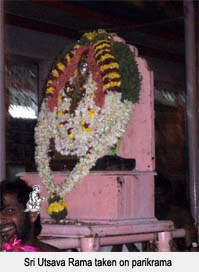 After settling down in the village Manchale, Guru Raghavendra built a temple for the village deity Manchalamma. He also desired that he wanted to build a temple for Lord Venkatesa Perumal of Tirupathi in the village of Manchale. With the help of Dewan Venkanna, the work progressed very fast in the village of Manchale, and Guru Raghavendra performed various yagyas and placed the (pradistha) Lord Venkatesa idol in the temple. When Diwan Venkanna repeatedly asked Guru Raghavendra as to why he chose this particular village, he asked Diwan to excavate a particular place. There Diwan found a homa kundam (a scared place square in shape where ritual fire is ignited and scarifies are offered to God). He then explained to the Diwan the reason for choosing this particular village as follows:
After settling down in the village Manchale, Guru Raghavendra built a temple for the village deity Manchalamma. He also desired that he wanted to build a temple for Lord Venkatesa Perumal of Tirupathi in the village of Manchale. With the help of Dewan Venkanna, the work progressed very fast in the village of Manchale, and Guru Raghavendra performed various yagyas and placed the (pradistha) Lord Venkatesa idol in the temple. When Diwan Venkanna repeatedly asked Guru Raghavendra as to why he chose this particular village, he asked Diwan to excavate a particular place. There Diwan found a homa kundam (a scared place square in shape where ritual fire is ignited and scarifies are offered to God). He then explained to the Diwan the reason for choosing this particular village as follows:
Guru Raghavendra was born as Bhaktha Prahaladha during Krida Yuga (period). And had performed various yagyas in this particular place and got full blessings of Lord Narayana. During Dwavabhara Yuga, Arjuna, who was on a victory journey in connection with Rajasuya Yagya, could not win over the local cheifton Anusalva. It is because of the reason that Anusalva was standing in this scared place and waging the war against Arjuna. Only after Anusalva was moved out of this scared spot could he be conquered by Arjuna. Such is the mahima of this place; hence, Guru Raghavendra had chosen this place for his Brindavan.
Panchamuka Anjaneya
While staying at Manchale, Guru Raghavendra used to visit a nearby place called Ganathalam (Gandhal village in Raichur District) and stay in a particular cave for meditation. On one fine day while on meditation, Guru Raghavendra had dharshan of Lord Sri Anjaneya with five faces at this cave. Even today devotees make it point to visit this place where Guru Raghavendra had dharshan of Lord Sri Anjaneya. Today the place is called Panchamuki.
Brindavan
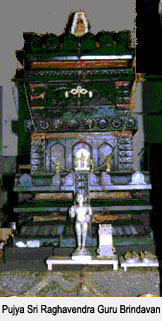 Saints who practice dvaita philosophy chose a scared place of their choice to relieve themselves from this mortal coil and obtain jeevamukti. In the scared place, a Brinda plant (Tulasi) is planted, and the place is worshipped for invoking the blessings of the aint. Guru Raghavendra chose a big black rock that was on the bank of the river Thungabadra to be brought to Manthralaya. He had the vision through MoolaRama, whom he worshipped every day, that rock had been sanctified by Sri Rama during his search of Sri Sita. The scared rock had been used for making the Brindavan, and a portion of the rock had been used for sculpturing a vigraha for Lord Anjaneya. The Vigraha is now consecrated opposite to the moola Brindavan.
Saints who practice dvaita philosophy chose a scared place of their choice to relieve themselves from this mortal coil and obtain jeevamukti. In the scared place, a Brinda plant (Tulasi) is planted, and the place is worshipped for invoking the blessings of the aint. Guru Raghavendra chose a big black rock that was on the bank of the river Thungabadra to be brought to Manthralaya. He had the vision through MoolaRama, whom he worshipped every day, that rock had been sanctified by Sri Rama during his search of Sri Sita. The scared rock had been used for making the Brindavan, and a portion of the rock had been used for sculpturing a vigraha for Lord Anjaneya. The Vigraha is now consecrated opposite to the moola Brindavan.
Before entering the Brindavan in Manchale, Guru Raghavendra decided to seek the permission of Manchalamma, the presiding deity of Manchale. Accordingly, he went to her temple and prayed to her. As wished by Her, he promised to bestow his blessings on the devotees only after they had first visited Her temple.
Entering Brindavan
On the day chosen (Virodhikruth Samvatsara Shravana krishna paksha dwitiya, 1671 A.D.), thousands of people had congregated in Manchale to see this rare event of a person entering a Brindavan alive. Guru first performed his daily pooja to the Moola Rama and then addressed his disciples.
Guru then took his veena and started to sing the famous song,"Indu Enege Govinda," set in Bhairavi raga. Just as in his previous avatAra as VyAsaraja, in this avatara also the blue darling of Brindavan in the form of an icon danced to the melodious of his darling who was going to enter the Brindavan. For some time he was in meditation, shining with a rare brilliance. His hands stopped moving the japamala. That was the sign, and his disciples started arranging slabs up to his head. As per Guru's earlier instructions, they placed a copper box containing one thousand two hundred saligramas. Then they placed the covering slab over it and filled it with earth. Thus Guru left his mortal coil to enter the eternal bless.
Today live in Brindavan.
An incident that has happened just after Guru entered the Brindavan is proof of his presence. Sri Appanacharya, a beloved disciple who composed many poems, was struck on the other bank of the Thugabhadra River and could not attend the ceremony. He came running, singing in praise of his Guru, only to see that the last covering slab was in place. The poem he was reciting could not be completed by him on seeing that. But a golden voice from inside the Brindavan said, "Sakshi haya syotra hi" (meaning that Lord Hayagriva is the witness to the statements made by Appanacharya in his stostra and that He would make them all come true). Even today, anybody reciting this stostra with full faith and devotion gets all the grace of Guru Rahavendra.
Santam shrIramaNa priyam yativaram vyAsasya bhAvebrishan
DurvArAmitamAyi bhikshutimire paryasya chandram bhuvi |
Satsandasthutamishta dakshitiruham vandAruvi prAshrayam
Tam NatvA sakalo durUhasudrasham samyAti vidyAdikam ||
|| Hari sarvothamaha Vayu jeevothmaha ||
||Mukhya Praanantargata Sitapati Sri Ramachandra preeyataam||
Ed [September 2008]
